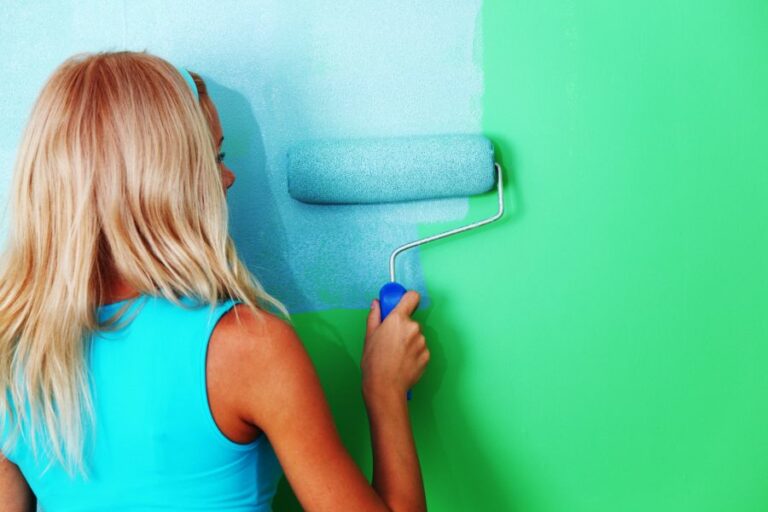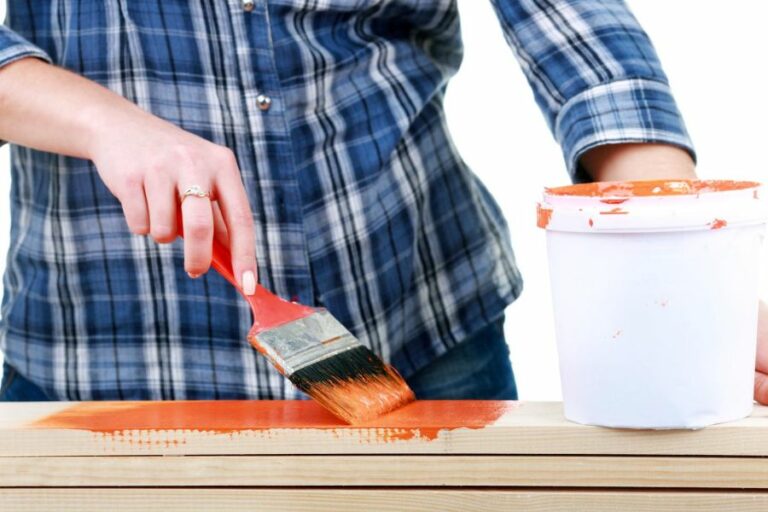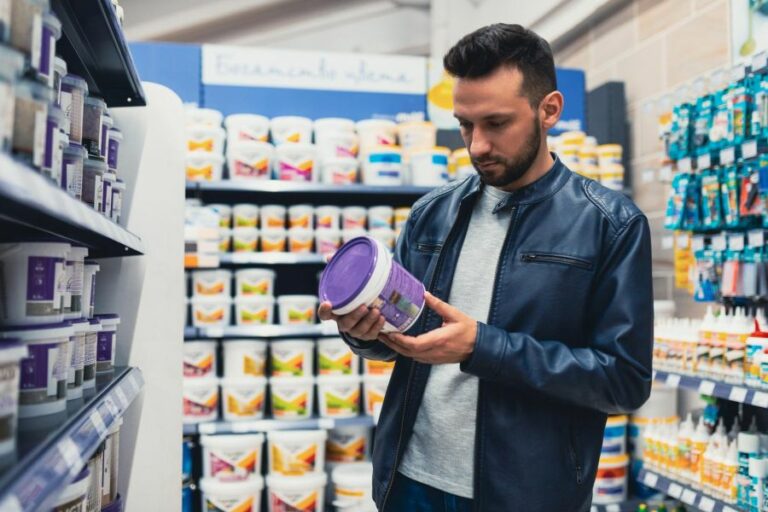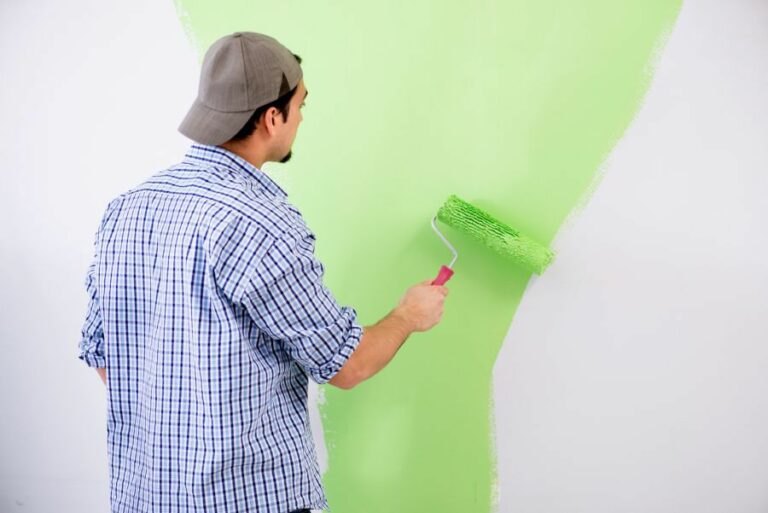Benefits Of Indoor Painting Primer, 25 Things You Should Know
Are you planning on giving your home a fresh look with a new coat of paint? Before diving into your painting project, let’s discuss the importance of indoor primer and its benefits. With my expertise, I’ll help you understand how investing in a good primer can make a huge difference in your painted walls’ final look and durability.
Benefits of indoor painting primer:
Indoor painting primer offers multiple benefits, including enhancing paint adhesion, improving visual appeal, covering stains and imperfections, increasing durability, saving on paint costs, and reducing odors. Using primer results in a more professional-looking, long-lasting, and cost-effective paint job while addressing specific concerns such as odor-blocking or mold resistance.

Looking to give your interior walls a fresh new look? Discover how using an indoor painting primer can make all the difference! Read on as I reveal the numerous benefits and tips for achieving that perfect finish. Let’s explore how primer can transform your painting project!
Contents
- 1 Advantages of Interior Painting Primer
- 2 Importance of Primer in Interior Painting
- 3 Importance of Interior Paint Primer Explained
- 3.1 • A Strong Base for Paint Adhesion
- 3.2 • Enhanced Color Vibrancy and Uniformity
- 3.3 • Sealant for Porous Surfaces
- 3.4 • Extended Paint Durability
- 3.5 • Superior Coverage for Stains and Odors
- 3.6 • Improved Efficiency and Reduced Costs
- 3.7 • When to Use Interior Paint Primer
- 3.8 • Selecting the Right Primer
- 4 Utilizing Paint Primer Indoors
Advantages of Interior Painting Primer
• Enhances Adhesion
One of the primary benefits of using an indoor painting primer is that it provides an ideal surface for the paint to adhere to. This increased adhesion can help prevent a wide range of problems, such as chipping, peeling, and flaking, which can ruin the look and longevity of your paint job.
This is especially important for surfaces that may be slick, such as glossy or semi-gloss paint finishes. According to The U.S. General Services Administration, priming glossy surfaces helps ensure proper adherence of the paint to the surface, resulting in a more durable finish.
• Improves Visual Appeal
Priming your walls before applying paint can also greatly improve the overall look and aesthetic of your paint job. By creating a uniform base, primers can help prevent uneven color application and the appearance of patches or blotches.
This makes it easier to achieve a professional-looking finish, even if you are doing the job yourself.
• Covers Stains and Imperfections
Another advantage of using an indoor painting primer is that it can help cover and conceal stains, blemishes, and imperfections on the surface being painted.
This is particularly useful for walls with water stains, ink, or other dark marks, as well as areas with significant color variations from previous paint jobs.
By applying a primer before the paint, you can create a more uniform surface, both in terms of color and texture, making it easier to achieve a flawless final result.
• Increases Durability
Indoor painting primers can also help increase the durability and lifespan of your paint job.
By providing a protective barrier between the paint and the underlying surface, primers can help reduce the risk of damage from moisture, temperature fluctuations, and other factors that can cause paint to crack, peel, or fade.
This can ultimately increase the longevity of your paint job, saving you both time and money in the long run.
• Better Coverage and Saves on Paint Costs
The cohesive nature of primers helps them create an even base on your walls, which in turn results in better coverage from your paint. By doing so, you may effectively require fewer coats of paint to achieve the desired opacity and appearance, ultimately saving on paint costs.
In addition, primers are generally more cost-effective than paint. Therefore, using a primer helps you cut down on overall expenses when painting a room or any indoor space.
• Reduces Odors and Blocks Stains
Some indoor painting primers are specifically formulated to reduce and block odors as well as stains from seeping through the paint. This can be particularly useful when painting rooms that have experienced smoke or fire damage or areas prone to strong odors, such as kitchens and bathrooms.
• Tips for Choosing and Applying Indoor Painting Primers
Based on my experience, I recommend the following tips for choosing and applying indoor painting primers:
- Start by thoroughly cleaning and prepping the surface you will be painting. Remove as much dirt, dust, and grime as possible, and be sure to repair any holes or cracks in the wall.
- Choose the right type of primer for your specific needs. Latex primers are water-based and usually suitable for most interior surfaces, while oil-based primers are better for blocking stains and can be used over oil-based paints. Additionally, specialty primers are available to address specific concerns, such as odor-blocking, mold resistance, or adhesion to certain materials.
- Use a high-quality brush or roller for application. Investing in the proper tools can make a significant difference in the outcome of your paint job.
- Apply the primer using even, methodical strokes, ensuring consistent coverage across the surface. Allow the primer to dry fully before applying the paint, as recommended by the manufacturer.
In conclusion, using an indoor painting primer can greatly improve the adhesion, appearance, durability, and cost-effectiveness of your paint job. By understanding the many benefits and properly applying primer, you can ensure a successful and long-lasting result for your interior painting project.
Importance of Primer in Interior Painting
When it comes to interior painting, many homeowners question the need for using a primer before applying their chosen paint color.
• The Purpose and Benefits of Primer
Primer is a preparatory coating applied to walls, ceilings, and any other surfaces before the paint is applied. It serves as a base that allows the paint to adhere better, ensuring a more even and durable finish. The key benefits of using primer for interior painting include the following:
– Enhanced Paint Adhesion
Primer creates a smooth and uniform surface for the paint to bond with, resulting in better adhesion and a longer-lasting finish. This is particularly beneficial when painting surfaces that may have existing layers of paint, as it helps the new paint to adhere properly.
– Improved Paint Coverage
By providing an even base, primer improves the paint’s coverage and prevents patchy or uneven results. This often means fewer coats of paint are required, potentially saving time and money.
– Better Color Quality
Primer can help to bring out the true tone and vibrancy of paint. It prevents the original surface from showing through, which could impact the color and overall appearance of the newly painted walls.
– Increased Durability & Protection
Using primer helps create a more durable paint job that is less prone to peeling, cracking, or fading. A properly prepared surface will also provide better protection against moisture, mold, and mildew.
• When Is Primer Necessary?
Though primer can be beneficial, there are specific situations where it is essential to achieve optimal results.
– New or Uncoated Surfaces
This includes surfaces such as untreated wood or new drywall. Using a primer is vital to create a suitable base for the paint to adhere to, preventing issues with absorption or uneven coverage.
– Changing Colors or Covering Stains
When changing the color of a room or covering stains, primer is necessary. For instance, a stain-blocking primer can help seal in difficult stains or odors, while a tinted primer can be beneficial when transitioning from a darker to a lighter color.
– Repairing Damaged Surfaces
In cases of patchy or cracked surfaces or areas where repairs have been made, using a primer can help blend the repaired area with the rest of the wall. It’s particularly useful when dealing with patches of different textures or colors from the surrounding surface.
– Painting Over Glossy or Smooth Surfaces
Surfaces with a glossy or smooth finish can cause adhesion issues for paint, resulting in peeling or uneven coverage. A primer can help create a better bond, improving adhesion and the overall finish.
• Selecting the Right Primer
There are various types of primers available, and it’s crucial to choose the right one for your project. Some common types include:
- Latex Primer: This water-based primer is suitable for most interior surfaces and is easy to clean.
- Oil-Based Primer: Suitable for wood surfaces, this primer provides excellent stain-blocking properties and adheres well to most surfaces.
- Shellac Primer: This type of primer is great for sealing in stubborn stains and odors, making it ideal when dealing with smoke or water damage.
Experts often recommend checking with the paint manufacturer to determine the most compatible primer for the specific paint product you intend to use.
• Expert Recommendations
From our experience, it is essential to prioritize proper surface preparation and use primer when necessary. Doing so can significantly impact the final result of your interior painting project. It’s always better to invest time and effort upfront to ensure a smooth, even, and long-lasting paint job.
In conclusion, while primer may not be necessary for every interior painting project, its benefits make it well worth considering. Primer provides a solid base for paint to adhere to, improves coverage and color quality, and promotes more durable and protective finishes.
So, before starting your next interior painting project, weigh the benefits and decide whether incorporating primer is necessary to achieve the best possible results.
Importance of Interior Paint Primer Explained
Painting the interior of a house is not just about selecting the perfect color and applying it to the walls. When it comes to achieving a long-lasting, beautiful finish, the priming step is considered a critical part of the process.
Primer, an often overlooked yet indispensable component in painting, is designed to prepare the surface for the paint to adhere effectively.
• A Strong Base for Paint Adhesion
One of the critical roles of primer is to provide a proper base for paint adhesion. By applying it on the surface before the paint, you ensure that the paint bonds well with the wall, preventing peeling, cracking, and other common issues that may appear over time.
Primer eliminates the problem of uneven or porous surfaces, thereby improving overall paint adhesion.
A Well-Known Priming Product: Kilz Primer
• Enhanced Color Vibrancy and Uniformity
Primer helps create a uniform base for the topcoat, which, in turn, ensures that the final color is vibrant and consistent across the entire surface. In many cases, primers have properties designed specifically to enhance paint color, such as white pigmentation.
By using primer, you ensure that the final color won’t be affected by any underlying stains, patches, or dark colors on the surface.
• Sealant for Porous Surfaces
Another primary function of the primer is to serve as a sealant for porous surfaces, such as wood or drywall. Unsealed surfaces have a tendency to absorb paint unevenly, eventually leading to an irregular appearance and uneven coverage.
Primer prevents these inconsistencies by sealing the pores and ensuring a smooth, even surface for proper paint application.
A Comprehensive Guide on Porous Surfaces: EPA – Porous Surfaces
• Extended Paint Durability
When applied correctly, primer can significantly enhance the durability of the paint. It acts as a protective layer, shielding the surface from moisture, stains, and other damaging factors that can compromise the structural integrity of the walls.
By using primer, you’re investing in a long-lasting paint job and reducing your chances of needing frequent touch-ups or repainting.
• Superior Coverage for Stains and Odors
Primer is specifically formulated to conceal stains and neutralize unpleasant odors. Many primers are oil-based or include stain-blocking additives, ensuring that the paint covers any existing blemishes effectively.
This is particularly beneficial if you’re painting over stained walls, water damage, or smoke damage, as primer can keep these unwanted marks from showing through the paint.
• Improved Efficiency and Reduced Costs
Using a primer can actually save you money in the long run. A primed surface typically requires fewer coats of paint to achieve the desired color and opacity, thereby reducing labor costs and the quantity of paint needed.
You may be able to save both time and money by incorporating primer into your painting project.
• When to Use Interior Paint Primer
Not all painting jobs require a primer, but there are certain situations where it’s highly recommended:
- When painting over a dark color with a lighter one
- When painting on an unpainted, porous surface (e.g., drywall or wood)
- In areas prone to moisture (e.g., bathrooms and kitchens)
- When covering stains or damage from water, smoke, mold, or mildew
• Selecting the Right Primer
Various types of interior paint primers are available in the market, catering to different surface materials and specific applications. It’s crucial to select the right primer for your project based on the surface you’re working with and your desired finish. Some common primer types include:
- Latex-based primer: Suitable for most surfaces, this water-based primer offers excellent coverage and is easy to clean up.
- Oil-based primer: Commonly used for wood surfaces, it provides superior adhesion and stain-blocking properties.
- Shellac-based primer: With excellent sealing properties, this primer works well for sealing knots, odors, and severe stains.
- High-hiding primer: Designed to cover bold colors and dark marks, this primer is ideal for drastic color changes.
In conclusion, the primary purpose of interior paint primer is to prepare the surface, ensuring optimal adhesion, color vibrancy, and durability. Investing in the right primer for your painting project can save both time and money while providing the best possible outcome for your home’s interior walls.
Utilizing Paint Primer Indoors
• Overview of Paint Primers
Paint primers are essential in achieving professional-quality results in any painting project. They are designed to improve the adhesion, durability, and overall appearance of the topcoat of paint.
• Improved Adhesion
One of the key benefits of using paint primer is improved adhesion. Primers are formulated specifically to provide a smooth surface for the topcoat of paint to adhere to. This enhanced adhesion ensures that the paint sticks properly to the surface, reducing the likelihood of peeling or flaking.
For surfaces such as metal or glossy surfaces, using a primer designed for these materials will greatly enhance the quality and longevity of the finish.
Here is an excellent resource for understanding adhesion and primers from a reliable source: Adhesion and Primers – Purdue University
• Enhanced Durability
With the increased adhesion provided by paint primer, the durability of the paint will also be improved. Primer helps create a tight bond between the surface and the paint, ensuring that the paint will withstand everyday wear and tear.
This is particularly important in high-traffic areas and on surfaces that will be exposed to various elements, as they will be more likely to encounter damage. Using a high-quality primer will help protect your paint job from chipping, scuffing, and fading, ultimately extending the life of your paint job.
• Superior Coverage and Color Accuracy
Using a primer before applying the topcoat of paint can significantly improve the coverage and appearance of the color you choose. Primers are specifically formulated to provide an even base, allowing the paint to cover more uniformly.
This means you will need fewer coats of paint to achieve the desired result, ultimately saving you time and paint in the long run.
Moreover, the primer helps maintain the true color of the paint, as it prevents existing colors or stains from bleeding through.
For instance, if you plan to paint a dark-colored wall with a lighter shade, using a primer beforehand will ensure a more accurate representation of the new color without any interference from the previous hue.
• Seamless Surface and Reduced Imperfections
Primers play a crucial role in creating a smooth, even surface to ensure a flawless finish. They are designed to fill in small gaps, pores, and small imperfections on the surfaces being painted, resulting in a smoother, more uniform appearance.
This quality is particularly beneficial when painting surfaces like bare wood or textured walls, as it reduces the need for extensive surface preparation before painting.
• Enhanced Mould and Mildew Resistance
Another significant benefit of using a primer is its ability to resist mold and mildew. Many primers on the market are formulated with anti-microbial additives that inhibit mold and mildew growth.
This can be a valuable feature, especially in rooms with high moisture levels, such as bathrooms and kitchens, or in regions with humid climates. Using a primer with these additives will help protect your surfaces from any potential water damage and ensure a cleaner, healthier space.
• Cost Efficiency
While the initial expense of purchasing a primer may seem like an added cost, it can ultimately save you money in the long run. As previously mentioned, using a primer ensures better paint coverage, which means you will require fewer coats of paint to achieve the desired result.
This translates to less paint being used and reducing overall painting costs. Moreover, the enhanced durability provided by a primer ensures your paint job will last longer, reducing the need for frequent touch-ups or repaints.
• Recommended Application Techniques
For optimal results, it is essential to apply the primer correctly. Always adhere to the manufacturer’s instructions on the primer packaging for proper surface preparation, application, and drying times.
Following these recommendations, along with using appropriate brushes and rollers, will help ensure a professional-quality finish in your paint projects.
• In Conclusion
Incorporating paint primer into your painting projects can provide numerous benefits, including improved adhesion, durability, superior coverage, seamless surface, mold, and mildew resistance, and cost efficiency.
By understanding the importance of using paint primer and utilizing the appropriate application techniques, you can ensure your paint projects have a professional-quality appearance and longevity.







